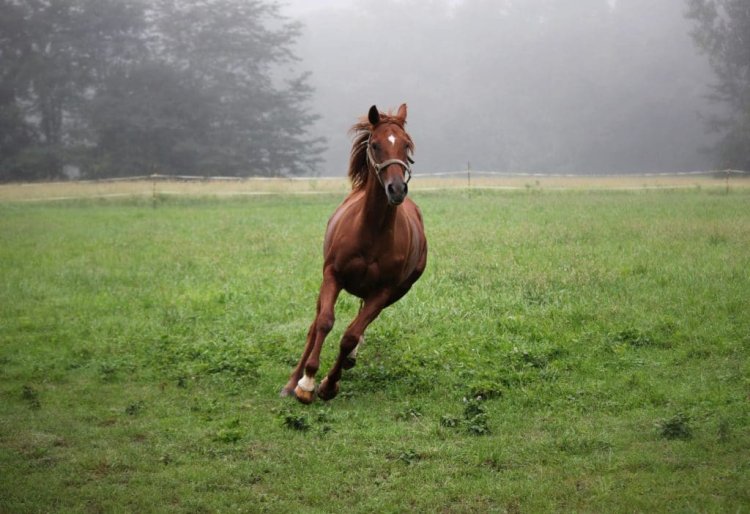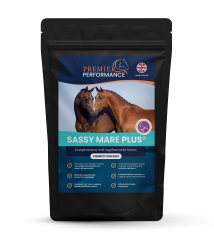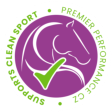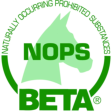in basket
Reproduction & behaviour in the mare

Difficult, moody, temperamental are all words that some use to describe their mare when her behaviour is inappropriate or unpredictable. Your mare’s behaviour can be affected by her reproductive cycle and to fully appreciate this it’s important to understand her reproductive anatomy and physiology, and the impact that has on her behaviour.
It’s also important to be able to recognise when her reproductive cycle and/or behaviour is abnormal to determine if veterinary advice is required. Therefore, this article covers normal and abnormal reproductive cyclicity and behaviour in mares and discusses how nutritional management of the healthy mare can help alleviate any undesirable behaviours.
Reproductive anatomy and physiology of a mare
The mare is known as a seasonal breeder that has a series of ovarian activity, known as oestrous cycles, during the breeding season. The mare is a ‘long day’ breeder in that the breeding season typically begins in early spring and ends in the autumn, which coincides with longer day lengths. The length of the breeding season is quite variable and depends to a large extent on breed. The longest day of the year is the 22nd June and it is around this time that mares reach their peak reproductive activity. When mares are not in the breeding season, they are described as being in anoestrus and this is usually during the winter months. During this period, mares show no signs of reproductive activity, either behaviourally or physiologically. However, there can be some breed variation in this; for example, thoroughbreds (TB) usually begin to cycle earlier in the year compared to native breeds. The mare’s reproductive season can also be manipulated with artificial light and administration of hormones, which is often used to bring the breeding season forward in TBs due to 1st January foaling date rule imposed by organisations that regulate TB breeding.
Most mares have a transition period in early spring where they move from anoestrus to oestrus as day length increases and they usually begin to show signs of oestrus in March, although the first cycle of the year is typically silent (no behavioural oestrus). This is known as a transition period because ovulations don’t become regular until around one month following the first period of oestrus. When they are reproductively cycling mares typically have a 21-day ovarian cycle, which is the interval from one ovulation to the next. However, this 21-day period can vary between mares and also time of year. This 21-day cycle is further divided into two periods known as the follicular phase (oestrus), which generally lasts 4-7 days (but can vary from 2-12 days), followed by the period known as the luteal phase (dioestrus), which tends to be relatively constant at 14-15 days. Oestrus, also known as the “heat” period, is when the mare is ovulating and is typically receptive to the stallion, with ovulation (the release of the egg from the ovary) taking place 24-48 hours before the end of this period. During dioestrus, the mare is unreceptive to the stallion. During the transition phase, mares can have long and erratic periods of oestrus (heat) as a consequence of their hormonal status.
The mare’s ovaries have two main roles, 1) they contain the eggs and 2) they secrete hormones: two important ones being oestrogen and progesterone. Hormonal changes take place during the oestrous cycle during both the follicular and the luteal phases. The follicular phase is at the start of oestrus when the mare’s eggs in the follicles begin to mature ready for ovulation. The luteal phase begins just after ovulation has taken place and this is when progesterone levels begin to rise to prepare the uterus for an impending pregnancy.
Hormones and behaviour in mares
During oestrus (heat), oestrogen drives the final stages of follicle growth and development, and also helps the mare to be receptive to the stallion. A mare in heat will typically raise her tail, urinate repeatedly (and ‘winking’ her vulva), squealing at other horses and may become more distracted when handling and riding. She may also interact unpredictably with people and other horses. This behaviour is normal and usually last between 4 to 7 days, becoming more intense as she nears ovulation as more and more oestrogen is being produced. Once the mare has ovulated, she goes out of ‘heat’ and her ovaries produce progesterone, which prepares the mare for pregnancy. At this time the mare is unreceptive to the stallion, but her behaviour during handling/training should be unaffected.
Abnormal reproductive cycles and behaviour in mares
It’s important to determine if any undesirable behaviours are related to oestrus by keeping a diary to determine if the behaviours are cyclical i.e. they occur in a pattern each 21-day cycle. Also, if the behaviour continues into the winter months when the mare is in anoestrus then it’s very likely that the behaviour is not related to her normal reproductive cycle. However, if your mare’s cycle is inconsistent or she has an extended oestrus/cycle then this may signal an underlying issue and it is important that you consult your veterinarian. For example, an abnormal cycle can be due to poor nutrition, a uterine infection, pituitary pars intermedia dysfunction (previously knowns as Cushing’s disease), or an ovarian tumour (known as a granulosa cell tumour). In mares with ovarian tumours the behaviour is usually more extreme, where mares can exhibit aggression and nymphomania. This is one of the more common tumours in horses. Mares who have these tumours are typically infertile, and the aggression and nymphomania occurs as a result of excessively high levels of testosterone being produced.
Your mare may show other symptoms that you may not necessarily think are related to her reproductive cycle, such as poor performance, a sore back, lameness, abdominal pain, reluctance to work, bucking, difficulty tacking up and refusal to move forwards (possibly resulting in rearing), but they can be due to an ovarian tumour for example. Some of these symptoms can also be similar to other issues such as equine gastric ulcer syndrome (EGUS) and therefore veterinary consultation is paramount.
Nutritional management of your mare
In healthy mares, dietary management should follow the advice provided in my previous articles. If your mare’s excitable in general, then I would again suggest following my previous advice on providing a diet high in fibre and low in starch, feeding little and often and avoiding long periods without forage. If additional feeds are needed to meet energy requirements, then gradually introduce high-quality fibre feeds, such as alfalfa and sugar beet pulp. For performance horses undertaking high-intensity exercise, where feeds containing starch are required, provide this little and often and avoid large meals. Research studies suggest that horses fed diets containing starch are likely to be more reactive than those horses fed a fibre-only diet. Therefore, if your mare is excitable it is best to avoid feeds that contain starch, such as concentrate mixes containing cereal grains (e.g. oats, barley, maize). Management is also important, for example amount of turnout and contact with other horses.
Some mares only exhibit undesirable behavioural changes during the follicular phase of their cycle with no behavioural issues during the luteal phase. In this instance, the above advice is also relevant, but in addition to this treatment can be aimed at increasing the levels of circulating progesterone to mimic the dioestrus phase of the mare’s cycle. Firstly, it’s important to note that if you are competing your mare then you need to ensure that any supplements fed are not restricted for use under competition rules. For example, Regumate is a liquid progesterone supplement that essentially prevents mares coming into heat. Regumate contains a synthetic form of progesterone called altrenogest, which is a controlled substance under FEI rules and means it is not allowed during competition. We recommend the use of Moody Mare Plus to help maintain natural healthy temperament, support muscles and maintain calm. Alternative supplements that may help alleviate some of the undesirable behaviours when mares are in heat by potentially increasing progesterone levels include vitamin C, vitamin B6, zinc and magnesium. These vitamins and minerals have been found to increase progesterone levels in women.
There are also a number of herbs that have been reported to increase progesterone levels in women; these include chasteberry, which has also been reported to decrease oestrogen levels as well as increasing progesterone levels in women and has long been used as a herbal remedy in many countries. This is an extract of the fruit and seeds of the chaste tree, which is also called Vitex agnus-castus. It’s important to note that chasteberry should not be fed to pregnant or lactating mares. Raspberry leaf is a supplement that contains phyto-progesterone and has also been reported to increase progesterone levels in women. Another supplement that has been reported to increase progesterone levels is l-arginine. As you may have read in previous articles, l-arginine is an amino acid that has many functions, including its conversion into nitric oxide (NO) in the body. Studies in women has shown daily supplementation of l-arginine to increase progesterone levels. Milk thistle is a herb that contains silymarin and can help support the liver in healthy detoxification and oestrogen metabolism, which is the body’s ability to breakdown oestrogens and remove them from the body. Similar to chasteberry, milk thistle should not be fed to pregnant or lactating mares.
Summary
- Monitor your mare’s behaviour and note if it is cyclical or persistent.
- If the behaviour is not cyclical and is present in winter then consult your veterinarian.
- Feed fibre first and then add on any additional feedstuffs only where required.
- If feeding high-starch concentrates then do so little and often and avoid large meals.
- Consider the use of supplements that can help increase progesterone levels, which may improve your mare’s behavior during heat.
Article written for Premier Performance by Professor Jo-Anne Murray.







